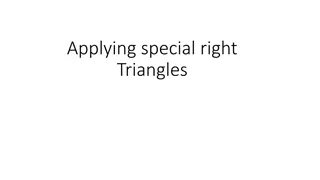Understanding Triangles: Importance and Applications in Engineering
Triangles play a crucial role in engineering by providing structural strength and stability. Unlike rectangles, triangles cannot be deformed without altering their sides or breaking their joints. They are used in various constructions like bridges, domes, and pyramids. Triangulation using triangles aids in precise measurements and distance calculations in real-world applications like surveying and construction.
Download Presentation

Please find below an Image/Link to download the presentation.
The content on the website is provided AS IS for your information and personal use only. It may not be sold, licensed, or shared on other websites without obtaining consent from the author. Download presentation by click this link. If you encounter any issues during the download, it is possible that the publisher has removed the file from their server.
E N D
Presentation Transcript
CLASS-IX SUB- MATHEMATICS TOPIC: TRIANGLES
Introduction: If there is a single most important shape in engineering, it is the triangle. Unlike a rectangle, a triangle cannot be deformed without changing the length of one of its sides or breaking one of its joints. In fact, one of the simplest ways to strengthen a rectangle is to add supports that form triangles at the rectangle's corners or across its diagonal length. A single support between two diagonal corners greatly strengthens a rectangle by turning it into two triangles. Triangulation of material, adds strength by eliminating lateral movement. Triangles are used to make rafters in buildings and curved domes. Some bridges have triangular structures, and the Egyptians made triangular-shaped pyramids. The shapes help surveyors use triangulation to determine the distance of a specific point from two other points of a known distance apart. Triangulation may be used to measure distances around corners and when digging tunnels, and carpenters use a right-angled triangle to take measurements
The Idea of Congruence of two Objects: Two figures with exactly the same size and shape. F B A C E D Congruency in real life(hyperlink)
How much do you need to know. . . . . . about two triangles to prove that they are congruent?
Corresponding Parts If all six pairs of corresponding parts (sides and angles) are congruent, then the triangles are congruent. 1. AB DE 2. BC EF 3. AC DF 4. A D 5. B E 6. C F ABC DEF
Do you need all six ? NO ! SSS SAS ASA AAS
Side-Side-Side (SSS) 1. AB DE 2. BC EF 3. AC DF ABC DEF
Side-Angle-Side (SAS) 1. AB DE 2. A D 3. AC DF ABC DEF included angle
Angle-Side-Angle (ASA) 1. A D 2. AB DE 3. B E ABC DEF included side
Angle-Angle-Side (AAS) 1. A D 2. B E 3. BC EF ABC DEF Non-included side
Warning: No SSA Postulate There is no such thing as an SSA postulate! E B F A C D NOT CONGRUENT
Warning: No AAA Postulate There is no such thing as an AAA postulate! E B A C F D NOT CONGRUENT
Axiom:7.1 (SAS congruence rule): Two triangles are congruent if two sides and the included angle of one triangle are equal to the sides and included angle of the other triangle. Why? (Because they are vertically opposite angles) So, Why? Why? (CPCT) Why? (as one pair of alternate interior angles are equal)
Now, try this: Why? (since they are alternate interior angle) (ii)AC=CA Why? (As it is the common arm) Hence, By ASA congruence condition,
Properties of a triangle Isosceles triangle property Converse of isosceles triangle property: hyperlink
Let us do this snowflake activity
Inequalities in a Triangle Let us Construct 3 different scalene triangle (that is a triangle in which all sides are of different lengths). Measure the lengths of the sides. Now, measure the angles. What do you observe? In ABC of Fig -1, BC is the longest side and AC is the shortest side. Also, A is the largest and B is the smallest. Repeat this activity for other two triangles. We arrive at a very important result of inequalities in a triangle. If two sides of a triangle are unequal, the angle opposite to the longer side is larger (or greater).
Now let us Construct 3 different triangles in which all angles are of different measure. Measure the angles of these triangles. Now, measure the length of sides. What do you observe? In ABC of Fig -1, A is the largest and BC is the longest side and side BC is the side opposite to A Repeat this activity for other two triangles. We arrive at a very important result of another inequality in a triangle. In any triangle, the side opposite to the larger (greater) angle is longer.
Let us perform an activity to prove these inequalities. (Hyperlink)























